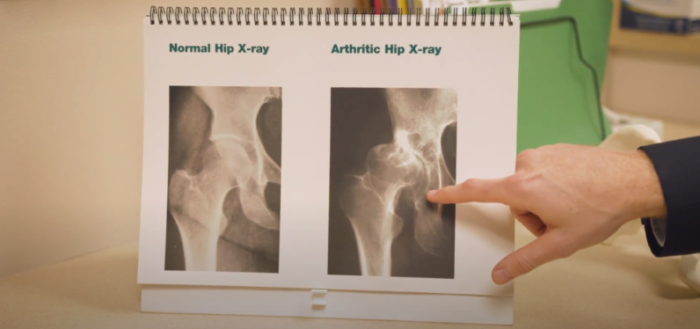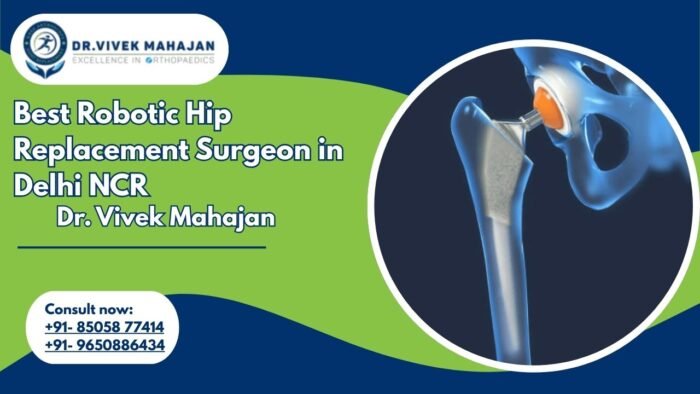Suppose hip osteoarthritis significantly impairs your ability to go about your daily activities because of pain and stiffness and traditional treatments have not worked. In that case, surgeons may suggest surgery to replace the arthritic joint with long-lasting artificial components or remove damaged cartilage.
Dr. Vivek Mahajan, a renowned hip replacement surgeon based in Delhi, is an expert in hip procedures. According to him, hip replacement surgeries are highly beneficial for alleviating hip pain, and stiffness and enhancing overall function and mobility.
What are hip replacement surgery and osteoarthritis?
Hip replacement surgery involves replacing a damaged hip joint with artificial components, offering relief from pain and improved mobility. Osteoarthritis is a joint condition characterized by cartilage degeneration, leading to pain and stiffness, often necessitating hip replacement surgery when other treatments fail.
How can total hip replacement help in osteoarthritis?
OR
Benefits of hip replacement to cure osteoarthritis
Total hip replacement is a helpful treatment option by addressing the pain, stiffness, and decreased mobility linked to osteoarthritis. How it helps is as follows:
- Pain relief: The degradation of the hip joint’s cartilage, osteoarthritis produces inflammation, pain, and bone-on-bone contact. By substituting artificial components for the damaged joint surfaces, total hip replacement reduces friction and relieves pain.
- Increased Mobility: Osteoarthritis frequently reduces the hip joint range of motion, making it challenging to carry out daily tasks. By substituting prosthetic parts that replicate the hip’s natural movement for the damaged joint, total hip replacement helps the patient regain mobility.
- Enhanced Functionality: The hip joint can become severely impaired by osteoarthritis, making it difficult to walk, climb stairs, or perform physical activities. Patients can resume these activities with increased comfort and ease with a total hip replacement because their hips are functional again.
- Long-Term Outcomes: Osteoarthritis symptoms are permanently relieved with a total hip replacement. The prosthetic parts used in the procedure are strong and made to resist the rigors of everyday living, providing patients with long-lasting pain relief and enhanced function.
- Enhanced Quality of Life: The effects of osteoarthritis, which include decreased mobility and chronic pain, can be significant. In addition to providing pain relief and mobility restoration, total hip replacement improves patients’ quality of life overall by allowing them to lead more active and satisfying lives.
Hip replacement surgery is a successful osteoarthritis treatment option, providing patients with considerable pain relief, increased mobility, increased functionality, long-term outcomes, and an all-around higher quality of life.
Self-care after the treatment
Self-care after hip replacement surgery is crucial for a successful recovery and optimal outcomes. Here are some essential self-care tips:
- Comply with Rehabilitation Instructions: Comply with the post-surgery rehabilitation regimen that your physician has prescribed. Physical therapy exercises are commonly used to strengthen hip muscles, enhance range of motion, and restore mobility.
- Keep an eye on the incision site: To avoid infection, keep the surgical incision clean and dry. As directed by your healthcare provider, take care of your wounds by changing dressings and protecting the area where you made the incision.
- Control Pain: To relieve pain following surgery, take prescribed painkillers as prescribed by your physician. Furthermore, icing the surgical site can aid in pain relief and edema reduction.
- Keep Yourself Hydrated: Drink plenty of fluids to stay hydrated, which aids healing and prevents complications such as blood clots.
- Keep Up a Healthy Diet: To promote healing and bolster your immune system, eat a balanced diet high in vitamins and minerals. Consuming enough protein is necessary for muscle recovery and tissue repair.
Osteoarthritis diagnosis
Before undergoing hip replacement surgery, it’s essential to consult with an orthopedic surgeon for a proper diagnosis of osteoarthritis. During this consultation, the surgeon will evaluate the condition of your affected hip compared to the other hip. They will assess your range of motion, examine how far you can move your hip and leg, and evaluate the strength of the muscles supporting your hip and leg. Additionally, the surgeon will review your medical history, including symptoms, previous treatments attempted, and any medications or supplements you are currently using.
For convenient access to treatment and aftercare for osteoarthritis, consider consulting with a renowned hip replacement surgeon in Delhi, such as Dr. Vivek Mahajan.
Dr. Mahajan specializes in hip replacement procedures and can provide comprehensive care to address osteoarthritis symptoms, ensuring optimal treatment and recovery.




nice information shared.
nice post shared.